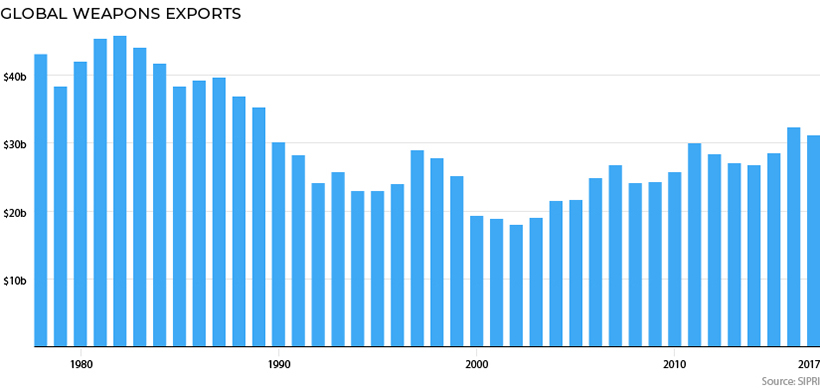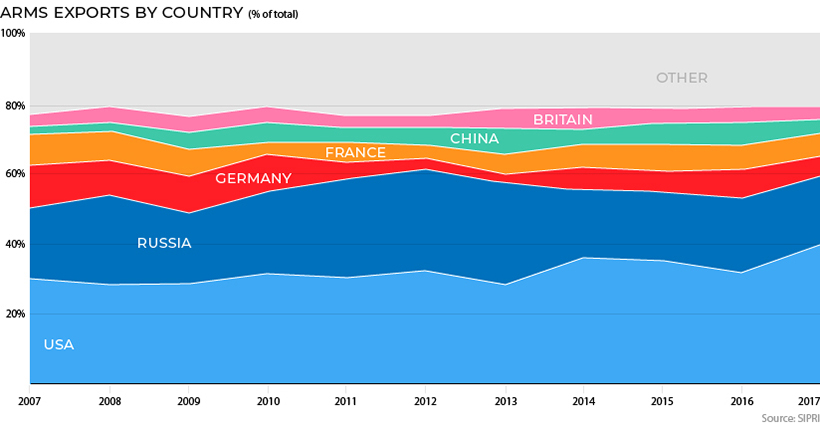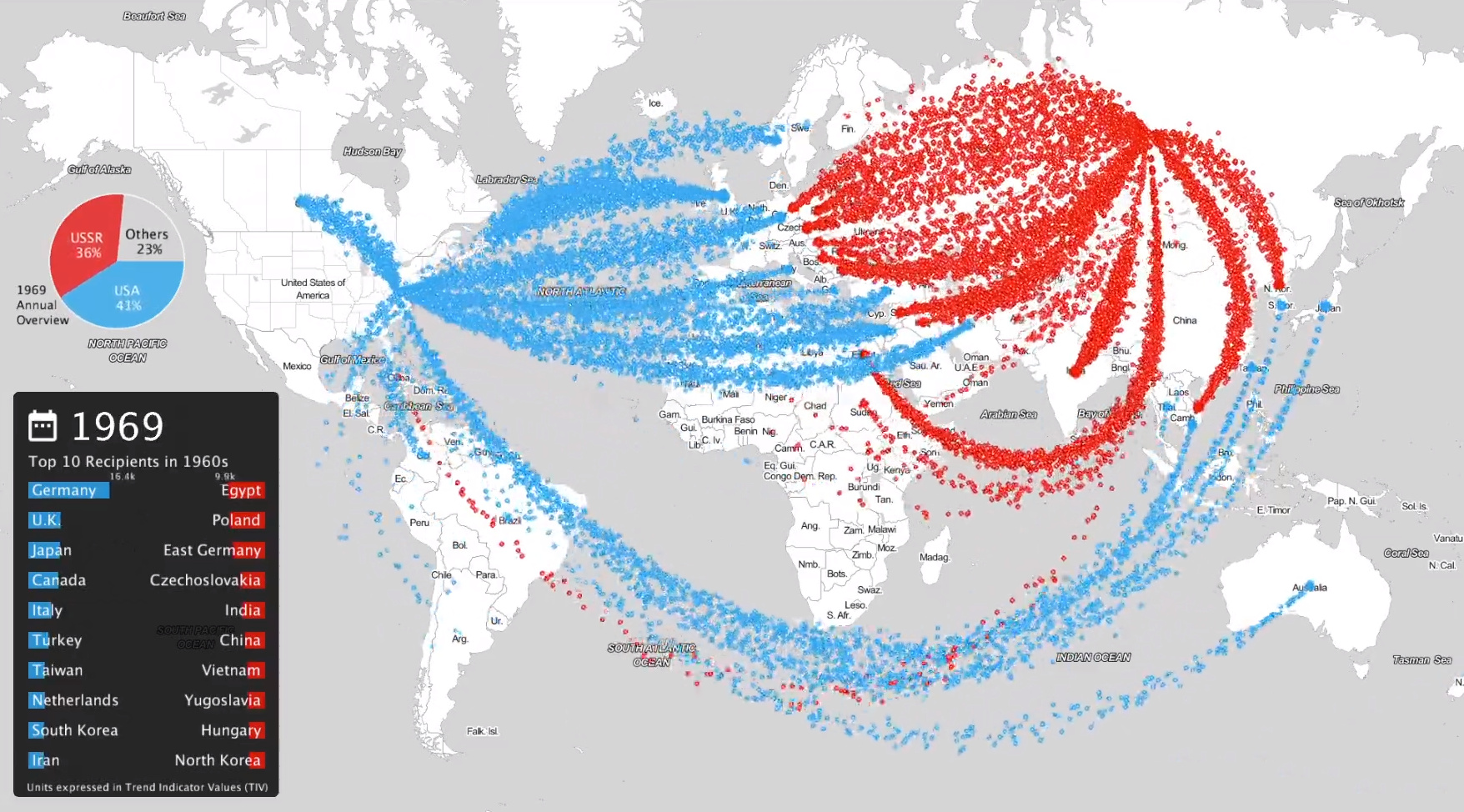For nearly half a century, the world’s two biggest superpowers were scrambling to top one another by any means necessary. It was a tension that ignited everything from the space race to sports rivalries, with the impact often spilling over to neighboring nations. Not only did the U.S. and Soviet Union duke it out in the mother of all arms races – they also extended their influence by selling arms outside of their borders. Interestingly, this latter race continues on until today, almost three decades after the fall of the Iron Curtain.
Visualizing Arms Sales
Today’s animation comes from data scientist Will Geary, and it shows the history of international arms sales originating from the U.S. and the Soviet Union (later Russia) from 1950 to 2017. More specifically, using data from the SIPRI Arms Transfers Database, the animation shows the geographic movement of arms from country to country as well as the evolving share of the arms trade held by the respective countries. The video is also pleasantly backed by audio that represents music from each decade, ranging from Buffalo Springfield to The Clash.
Peak Arms Dominance
If you watch the pie chart in the upper left corner of the animation, you’ll see that the early-1960s is the peak of U.S. and Soviet arm dominance – at this point, around the same time as the Cuban Missile Crisis and then the JFK assassination, the two superpowers combined for 80% of global arms sales. In the 1960s, the biggest customers of U.S. arms were Germany, the United Kingdom, and Japan – while the Soviets sent the most weapons to Egypt, Poland, and East Germany.
Fall of the Wall
By the 1980s, the global arms trade started dying down as Soviet leaders like Gorbachev focused on domestic reforms, and eventually perestroika. Later, the Soviet Union dissolved, and arms sales continued to plunge all the way to 2001:
Since then, arms sales have been ramping up again – and today, they are back at levels last seen before the Berlin Wall came down.
The Modern Era
Who is selling the most arms, according to the last 10 years of data?
Even though the Cold War is now long gone, the U.S. and Russia have kept their legacy of international arms sales going well into the 21st century. And today, the two nations combine for roughly 60% of arms sales, with top U.S. weapons manufacturers like Lockheed Martin and Raytheon getting a big slice of that pie. on Even while political regimes across these countries have changed over time, they’ve largely followed a few different types of governance. Today, every country can ultimately be classified into just nine broad forms of government systems. This map by Truman Du uses information from Wikipedia to map the government systems that rule the world today.
Countries By Type of Government
It’s important to note that this map charts government systems according to each country’s legal framework. Many countries have constitutions stating their de jure or legally recognized system of government, but their de facto or realized form of governance may be quite different. Here is a list of the stated government system of UN member states and observers as of January 2023: Let’s take a closer look at some of these systems.
Monarchies
Brought back into the spotlight after the death of Queen Elizabeth II of England in September 2022, this form of government has a single ruler. They carry titles from king and queen to sultan or emperor, and their government systems can be further divided into three modern types: constitutional, semi-constitutional, and absolute. A constitutional monarchy sees the monarch act as head of state within the parameters of a constitution, giving them little to no real power. For example, King Charles III is the head of 15 Commonwealth nations including Canada and Australia. However, each has their own head of government. On the other hand, a semi-constitutional monarchy lets the monarch or ruling royal family retain substantial political powers, as is the case in Jordan and Morocco. However, their monarchs still rule the country according to a democratic constitution and in concert with other institutions. Finally, an absolute monarchy is most like the monarchies of old, where the ruler has full power over governance, with modern examples including Saudi Arabia and Vatican City.
Republics
Unlike monarchies, the people hold the power in a republic government system, directly electing representatives to form government. Again, there are multiple types of modern republic governments: presidential, semi-presidential, and parliamentary. The presidential republic could be considered a direct progression from monarchies. This system has a strong and independent chief executive with extensive powers when it comes to domestic affairs and foreign policy. An example of this is the United States, where the President is both the head of state and the head of government. In a semi-presidential republic, the president is the head of state and has some executive powers that are independent of the legislature. However, the prime minister (or chancellor or equivalent title) is the head of government, responsible to the legislature along with the cabinet. Russia is a classic example of this type of government. The last type of republic system is parliamentary. In this system, the president is a figurehead, while the head of government holds real power and is validated by and accountable to the parliament. This type of system can be seen in Germany, Italy, and India and is akin to constitutional monarchies. It’s also important to point out that some parliamentary republic systems operate slightly differently. For example in South Africa, the president is both the head of state and government, but is elected directly by the legislature. This leaves them (and their ministries) potentially subject to parliamentary confidence.
One-Party State
Many of the systems above involve multiple political parties vying to rule and govern their respective countries. In a one-party state, also called a single-party state or single-party system, only one political party has the right to form government. All other political parties are either outlawed or only allowed limited participation in elections. In this system, a country’s head of state and head of government can be executive or ceremonial but political power is constitutionally linked to a single political movement. China is the most well-known example of this government system, with the General Secretary of the Communist Party of China ruling as the de facto leader since 1989.
Provisional
The final form of government is a provisional government formed as an interim or transitional government. In this system, an emergency governmental body is created to manage political transitions after the collapse of a government, or when a new state is formed. Often these evolve into fully constitutionalized systems, but sometimes they hold power for longer than expected. Some examples of countries that are considered provisional include Libya, Burkina Faso, and Chad.


















